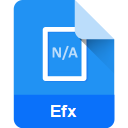.EFX File Extension

eFax Document
| Developer | j2 Global Communications |
| Popularity | |
| Category | Data Files |
| Format | .EFX |
| Cross Platform | Update Soon |
What is an EFX file?
The .EFX file extension is associated with a specific file format that serves various purposes across different platforms.
These files are utilized to store and exchange data in a structured format, enabling compatibility across multiple operating systems. Understanding the origin, history, and technical specifications of .EFX files is crucial for users seeking efficient data management and transfer.
More Information.
The .EFX file format was initially conceived with the primary purpose of providing a standardized way to store and share data.
Over time, it has become a versatile tool, finding applications in various domains such as multimedia, finance, and design. Its adaptability has contributed to its sustained relevance in the digital ecosystem.
Origin Of This File.
The origin of the .EFX file extension can be traced back to the evolving landscape of digital technology. Initially introduced to streamline data organization, these files have witnessed significant developments over the years, adapting to the changing needs of users across diverse industries.
File Structure Technical Specification.
The structure of .EFX files is defined by a set of technical specifications that outline how data is organized within the file. This includes information on data types, encoding methods, and any specific formatting rules.
The technical specifications ensure interoperability, making it possible for different systems to interpret and process .EFX files consistently.
How to Convert the File?
Windows:
Converting .EFX files on Windows is a straightforward process. Follow these steps to transform your .EFX file into a different format:
- Select Conversion Software: Choose a reliable file conversion software that supports the .EFX format. Popular options include FileZigZag, Zamzar, or dedicated software associated with the file type you wish to convert to.
- Install the Chosen Software: Download and install the selected conversion software on your Windows system. Follow the installation instructions provided by the software.
- Open the Software: Launch the installed software and locate the option for file conversion.
- Choose the .EFX File: Select the .EFX file you want to convert. Some software may allow you to drag and drop the file directly into the conversion interface.
- Select Output Format: Specify the desired output format for the converted file. Ensure compatibility with the software or platform you intend to use the file on.
- Initiate the Conversion: Start the conversion process by clicking the appropriate button. The software will process the .EFX file and generate the converted version in the chosen format.
- Verify the Output: Once the conversion is complete, check the converted file to ensure its integrity and that it meets your requirements.
Linux:
Converting .EFX files on a Linux system involves using compatible software. Here’s a guide to help you through the process:
- Choose Conversion Tool: Select a Linux-compatible file conversion tool that supports the .EFX format. Options like Pandoc or Calibre may be suitable.
- Install the Tool: Use your Linux package manager to install the chosen conversion tool.
- Open Terminal: Launch the terminal and navigate to the directory containing the .EFX file.
- Execute Conversion Command: Use the appropriate command to convert the .EFX file to your desired format. For Pandoc, the command might look like:
- Check the Converted File: Verify the converted file in the specified output format to ensure a successful conversion.
Mac:
Converting .EFX files on a Mac follows a similar process to Windows. Here’s a step-by-step guide:
- Choose Conversion Software: Select a file conversion application compatible with macOS that supports the .EFX format. Options include Online Convert, FileZigZag, or dedicated software associated with the desired output format.
- Install the Software: Download and install the chosen conversion software on your Mac. Follow the installation instructions provided.
- Launch the Software: Open the installed software and locate the section for file conversion.
- Load the .EFX File: Choose the .EFX file you want to convert, either by using the software’s interface or dragging and dropping the file.
- Specify Output Format: Indicate the desired output format for the conversion. Ensure compatibility with your intended use.
- Initiate Conversion: Start the conversion process by clicking the appropriate button. Allow the software to process the .EFX file and generate the converted version.
- Verify the Result: Check the converted file to ensure accuracy and suitability for your requirements.
Android:
Converting .EFX files on an Android device can be achieved with the help of dedicated apps. Follow these steps:
- Install a Conversion App: Visit the Google Play Store and install a file conversion app that supports the .EFX format. Apps like File Converter or Total Converter are popular choices.
- Open the App: Launch the installed app on your Android device.
- Select .EFX File: Choose the .EFX file you wish to convert from your device’s storage.
- Choose Output Format: Specify the output format for the conversion. Ensure compatibility with the apps or software you intend to use the file with.
- Initiate Conversion: Start the conversion process within the app. The app will process the .EFX file and create the converted version.
- Check the Converted File: Once the conversion is complete, verify the converted file to ensure it meets your requirements.
iOS:
Converting .EFX files on an iOS device involves using specialized apps from the App Store. Follow these steps:
- Install a Conversion App: Visit the App Store and install a file conversion app that supports the .EFX format. Apps like File Converter or Documents by Readdle are suitable choices.
- Open the App: Launch the installed app on your iOS device.
- Select .EFX File: Choose the .EFX file you want to convert from your device.
- Specify Output Format: Indicate the desired output format for the conversion. Ensure compatibility with the apps or software you plan to use the file with.
- Initiate Conversion: Start the conversion process within the app. The app will process the .EFX file and generate the converted version.
- Check the Converted File: Once the conversion is complete, verify the converted file to ensure it aligns with your requirements.
Advantages And Disadvantages.
Advantages:
- Versatility: .EFX files can accommodate diverse data types, making them suitable for various applications.
- Interoperability: The standardized format promotes compatibility across different platforms and software.
- Efficient Data Management: The structured nature of .EFX files facilitate organized storage and retrieval of information.
Disadvantages:
- Limited Awareness: Not all users may be familiar with the .EFX file format, potentially leading to compatibility issues.
- Dependency on Supporting Software: Opening and manipulating .EFX files may require specific software, limiting accessibility for some users.
How to Open EFX?
Open In Windows
.EFX files can be opened on Windows platforms using compatible software applications. Ensure that the appropriate program is installed to access and manipulate the file.
Open In Linux
Linux users can employ compatible software to open and work with .EFX files. Ensure that the chosen application is compatible with the Linux operating system.
Open In MAC
Mac users can utilize specific software applications designed for .EFX files. Check for compatibility and install the necessary program to access and edit the file.
Open In Android
On Android devices, users can access .EFX files using supporting applications. These apps can be sourced from the Google Play Store, providing a seamless experience on mobile devices.
Open In IOS
iOS users can open .EFX files using dedicated applications available on the App Store. Ensure compatibility and download the appropriate app to access the file on iOS devices.
Open in Others
For operating systems not covered above, users should explore software options compatible with their specific environment. This may involve searching for third-party applications or converters that support .EFX files.










